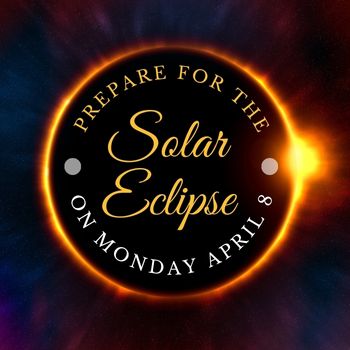
Join us at the Library on Monday, April 8 for a Solar Eclipse Viewing Party! Drop in between 10:30 am – 2:30 pm and get a pair of eclipse glasses or viewers (one per person while supplies last). Chicagoland is on the edge of the path of totality, and weather permitting, we’ll see a partial solar eclipse with the Moon covering a large portion of the Sun. Even if it’s cloudy, enjoy a live feed of the total eclipse playing in the Foyer, plus activities and refreshments.
The eclipse on April 8, 2024 is a total solar eclipse, which happens when the Moon passes between the Sun and the Earth, completely blocking the face of the Sun. Those within the path of totality (that is, locations where the Moon’s shadow completely covers the Sun) will experience this total solar eclipse. The sky will become dark, and people will be able to see the Sun’s corona, or outer atmosphere, which is usually obscured by the Sun’s light. The peak of the eclipse will last up to 4 minutes, 28 seconds in some locations, which is twice as long as the eclipse we saw in 2017. This will be the last total solar eclipse visible from the contiguous United States until 2044, and there won’t be another eclipse with a similar coast-to-coast path until 2045.
Since Northern Illinois is outside the path of totality, we will experience a partial solar eclipse, where the Moon covers most, but not all, of the Sun. Eclipse glasses are required for the entire duration of the eclipse when viewing from outside the path of totality. It is not safe to remove your eclipse glasses when the Moon is not completely blocking the Sun. For more safety information, visit NASA’s Total Solar Eclipse Safety page.
NASA also has more information on what to expect, an interactive visualization of the eclipse path, and photos from past eclipses. The Exploratorium (San Francisco, CA) will be broadcasting eclipse livestreams from the path of totality in Junction, Texas in both English and Spanish.
For even more information about eclipses and other astronomical wonders, be sure to check out these books, documentaries, and other Library resources:
-
American Eclipse: A Nation's Epic Race to Catch the Shadow of the Moon and Win the Glory of the World: This suspenseful narrative history of the 1878 eclipse brings to life the momentous event that enthralled a nation and thrust American science onto the world stage.
-
Astronomy magazine: Log in to Libby to check out current and backlist issues of Astronomy magazine for exciting, visually stunning, and timely coverage of the universe.
-
The Beginner’s Guide to Astrophotography: How to Capture the Cosmos with Any Camera: If you’re just starting your adventure in astrophotography, check out this adult nonfiction guide to learn how to plan a shoot, set up for it, and the best way to capture your photos.
-
Chasing Shadows: Log in to Kanopy to watch the story of Geoff Sims, a professional photographer and astronomer who has travelled the globe in pursuit of solar eclipses.
-
Eclipse Over America: Log in to Hoopla to view this NOVA documentary on the 2017 solar eclipse and learn about current research into the solar corona.
-
Eclipses: This children’s book provides a basic explanation of the science behind solar eclipses.
-
A Few Beautiful Minutes: Experiencing a Solar Eclipse: Sky gazers experience a total solar eclipse in this descriptive picture book about the wonders of this phenomenon.
-
Remarkable Science of Ancient Astronomy: Log in to Hoopla to watch this course from The Great Courses series showing how ancient civilizations saw the sky.
-
Sun, Moon, Earth: The History of Solar Eclipses from Omens of Doom to Einstein and Exoplanets: Check out this adult nonfiction title for more information on the history of solar eclipses.
-
Totality: The Great American Eclipses of 2017 and 2024: This adult nonfiction title provides detailed coverage of the upcoming eclipse, including information on how to safely view, photograph, and record it.